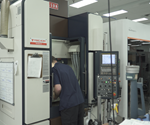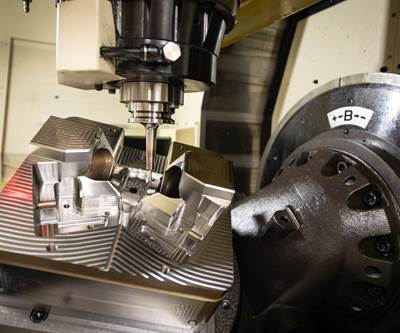Share
Read Next
Many shops tout expertise in the discipline of complex, multiple-cavity molds, but during my visit to Pro Mold & Die in Roselle, Illinois, I learned that it’s the definition of complexity that counts.
Twenty-five employees hustle around a 30,000-square-foot facility armed with modern software, and high-speed machining equipment prepped to deliver 24-hour continuous operation for designing and building injection molds, and die-cast dies. These tools range from small to large complex parts with multiple side actions and plates for the automotive, appliance, household, lawn and garden, and medical device markets.
This shop’s sweet spot is four- to eight-cavity complex plastic injection molds, two-shot (shooting two different materials at the same time) molds and family molds with six or eight different parts. That sounds like complexity to me. Plus, they back every tool they build with a comprehensive 12-month warranty.
When Pro Mold & Die Co-Owner Dave Long talks about mold complexity, he means a lot of moving parts and a level of work that must be dimensionally perfect. “To us, complex is not just tight tolerances. There are a lot of people who can do that. We're looking for a larger part with a lot of moving parts,” Long says.
For example, he mentions a four-cavity mold with four or five lifters in each part that might have 18, 20 or 30 moving parts in the mold. It's not just the tight tolerance; it's all the functions that come with the mold. Most of Pro Mold’s molds do not just open and close; there is a lot of sequencing involved to ensure that happens properly. “It’s all about what goes first, second, third, fourth, fifth, sixth, etc. before mold opening and closing. There are probably seven or eight actions that have to take place before you can even open the mold,” Long says. It sounds like you can really ruin a mold if you open it out of sequence.
When Pro Mold & Die Co-Owner Dave Long talks about mold complexity, he means a lot of moving parts and a level of work that must be dimensionally perfect.
Making It Mechanical
What lured me to Pro Mold was this photo. It is a two-cavity automotive-under the hood water outlet mold that Pro Mold recently completed (early). And, as of this writing, the customer has completed mold sampling with no required changes! Now, this mold doesn’t just ‘look’ complex (and quite beautiful, to boot); it is complex. It consists of 420 manufactured parts, 24 of which are moving.
Each cavity has 12 moving parts (slides, lifters, guides, pins, etc.), making a total of 24 moving parts for a part that's only the size of your fist. And, to move those 12 parts requires the other 408 parts in the mold, which they had to manufacture, and by ‘manufacture’, Long means the 420 parts were custom. They could not purchase any of those parts through a catalog. Plus, the mold weighs 14,000 pounds. 420 parts is a long cry from the typical 170 parts Long recalls from years ago.
Pro Mold has designed and manufactured water outlets in the past, but they made most movements with hydraulic cylinders. For this mold, they used mechanics to drive all the slides because this approach makes it easier for the customer to sequence the timing and it reduces the size of the mold, so that it would fit in the customer’s required press.
“The customer did not want all the cylinders that we used in previous molds. The sequencing is harder, and it takes a bigger press. This mechanical mold does cost more, but the customer was willing to pay a little more to have more mechanics, and not as much sequencing and cylinders that may leak. Our design is automatic — this triggers that before that triggers that. So, when you open the mold, things happen. It's easier for the customer,” Long says.
Managing the Mold Build
This complexity takes more than technology and skilled workers, it takes a team. Equipment is important, but people are critical. “Four of us are smarter than one of us,” Long recites from memory of a quote he saw on a conference room whiteboard at one of his customer’s facilities years ago.
“That has stuck with me. I believe we have a culture that encourages employees to work together on part design to provide the optimal design for manufacturing (DFM) to keep maintenance costs down and to make the mold more manufacturing-friendly,” Long says.
For example, when Pro Mold gets a part from a customer, the team looks at the part design to see if there are any avenues they can take to make the mold better while keeping costs, maintenance and delivery down and quality up. We all know that it’s one thing to design a part; it’s another to make it work.
Communication through the right channels among everyone who touches the mold is key to managing a complex mold like this one — what you do and when you do it. You can’t underestimate the management of over 400 pieces that must all come together at a certain time for assembly and fitting.
“If you don’t manage it properly, you could spend an awful lot of time and not need those parts for 12 weeks down the road. You can't miss anything either because you cannot order any of the parts overnight. It is the project manager’s job to manage what is needed when and see that it's done,” President and Co-Owner Walter Schaub says.
Pro Mold’s strategy includes regular project manager and engineering meetings using a Gantt chart that shows a mold project with target dates from design to shipping. It lays out the functions and processes for each part. This chart also hangs in the conference room where the team meets every morning at 8 am for a 10-minute stand-up meeting to discuss needs. Then every Monday morning, the president and owner hold a sit down meeting for about an hour to review the Gantt chart, set priorities for the day and plan the entire week. The customer also receives a copy of the Gantt chart with the delivery date and is welcome to stop in at any time.
“The key is to measure against your time to see where the team is and that resources are being used to get the right parts at the right time,” says Schaub.
A mold project of this magnitude, with different people making different components all due at specific times, demands diligent management of each part’s location and status so that the team completes the mold on time.
Getting Organized
Although everyone in the shop handled some aspect of this mold at one time or another, the core team to take it on was established with one-one-one training based on a two-minds-are-better-than-one attitude. A seasoned project manager/lead moldmaker took a young next-generation apprentice moldmaker under his wing. After six years, they both understand each other’s strengths and weaknesses. They are dialed in when it comes to communication. “It’s like a left hand and a right hand,” one of them said.
Together they both had the confidence in their abilities that they could get this particular job done given enough time. This team dual manages. Basically, one part of the team was managing the design and manufacturing of the 420 parts while the other was getting it done.
A mold project of this magnitude, with different people making different components all due at specific times, demands diligent management of each part’s location and status so that the team completes the mold on time. Otherwise, the mold builder can miss five parts that take four weeks to build. The engineering manager’s idea to provide detailed 3D drawings of the 12 different moving components proved absolutely beneficial to the project manager, mold builder, and the rest of the Pro Mold team.
“He itemized each of the 12 components in detail (slide 1, slide 2, slide 3, etc.) He took each slide assembly, broke it all down and made diagrams (instead of detail #293) in 3D, not blueprints. This helped the team know what does and does not need to be good,” Long says.
‘Needs to be good’ refers to the fact that the design for this project did not have the running clearance, which means the project manager and moldmaker had to handle that. These 24 moving parts (slides) each with six or seven components equals 70 or 80 components that are not moving square. Multi angles and ports are coming out at different angles for which the Pro Mold duo had to provide the clearance number, which is quite an accomplishment with all those angles, as opposed to straight slides.
“To put it in perspective, consider a slide that needs to travel, and if you made the slot in which it travels five inches on the design, the slide is five inches, and that won’t work. So, finding the correct clearance is critical, and for this job that falls on our team,” Long says. Plus, this mold runs on 320-degree pressurized water, so they had to factor in the heat of that component, and thermal expansion and distance to provide the clearance.
On top of that, they are working with different materials (beryllium copper, S7, H13, etc.) with different coefficient of expansion, which means running at that same temperature, you have to use different clearance values on them. Otherwise, you'll accumulate errors if you build clearance on everything. You have to put clearance in the right components so that it stays aligned correctly.
Communication through the right channels among everyone who touches the mold is key to managing a complex mold like this one — what you do and when you do it.
Making the Difference
Being organized and detailed, made this complex job much more manageable, but it was the Pro Mold team that got this mold to the finish line early. Maybe it was the seasoned mold maker/next-generation team approach that made the difference. All I know is the project manager admitted to me that this mold was “a little intimidating at first,” but when I asked if this was the most complicated mold that the young mold builder worked on, he replied, “I don't think it's that complicated.” Now, that’s an attitude we want all next-generation mold builders to have, and maybe it will rub off on the seasoned ones, too.
MoldMaking Technology Editorial Director finds out during a visit to Pro Mold & Die that Co-Owner Dave Long defines mold complexity as a lot of moving parts and a level of work that must be dimensionally perfect. Thanks to videographer MMT Assistant Editor Heather Wintle and video editor Austin Grogan.
For More Information
Pro Mold & Die / 630-893-3594 / promolddie.com
Read Next
2019 Leadtime Leader Award Winner: X-Cell Tool and Mold Inc.–The Continuous Drive for Perfection
Continued investment in new technologies and automation has enabled this moldmaker to maintain shorter lead times no matter how large or complex the mold build.
Read MoreCustom Mold & Design Chases Complex Mold and Production Part Projects with Top-of-the-Line Five-Axis, Screw, Mill/Turn, Additive and Molding Machines
Unique business model—with an eye on complex projects and an arsenal of machine technology to meet the required accuracy levels—raises the bar in mold and machined component manufacturing.
Read MoreReasons to Use Fiber Lasers for Mold Cleaning
Fiber lasers offer a simplicity, speed, control and portability, minimizing mold cleaning risks.
Read More


















